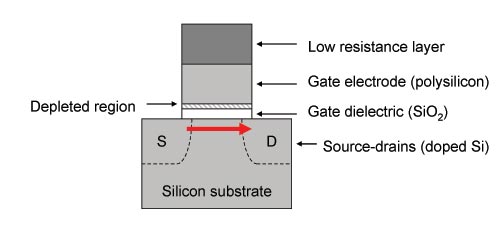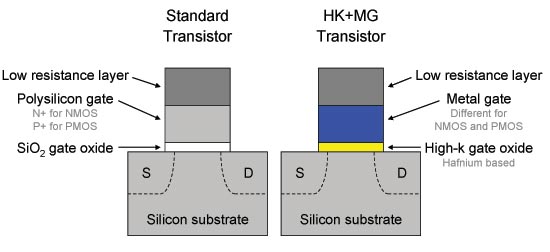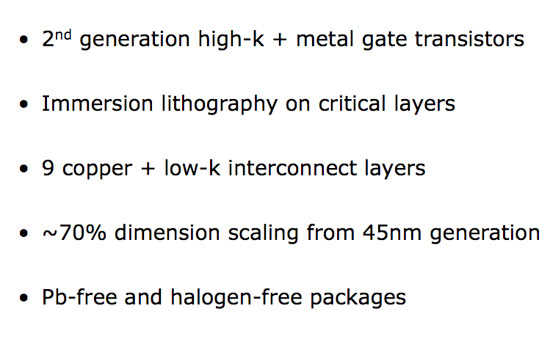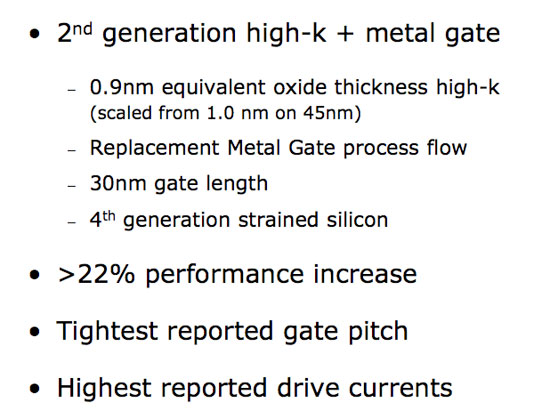Intel's 32nm Update: The Follow-on to Core i7 and More
by Anand Lal Shimpi on February 11, 2009 12:00 AM EST- Posted in
- CPUs
The Manufacturing Roadmap
The tick-tock cadence may have come about at the microprocessor level, but its roots have always been in manufacturing. As long as I’ve been running AnandTech, Intel has introduced a new manufacturing process every two years. In fact, since 1989 Intel has kept up this two year cycle.

We saw the first 45nm CPUs with the Penryn core back in late 2007. Penryn, released at the very high end, spent most of 2008 making its way mainstream. Now you can buy a 45nm Penryn CPU for less than $100.
The next process technology, which Intel refers to internally as P1268, shrinks transistor feature size down to 32nm. The table above shows you that first production will be in 2009 and, after a brief pause to check your calendars, that means this year. More specifically, Q4 of this year.
I’ll get to the products in a moment, but first let’s talk about the manufacturing process itself.
Here we have our basic CMOS transistor:

Current flows from source to drain when the transistor is on, and it isn’t supposed to flow when it’s off. Now as you shrink the transistor, all of its parts shrink. At 65nm Intel found that it couldn’t shrink the gate dielectric any more without leaking too much current through the gate itself. Back then the gate dielectric was 1.2nm thick (about the thickness of 5 atoms), but at 45nm Intel’s switched from a SiO2 gate dielectric to a high-k one using Hafnium. That’s where the high-k comes from.
The gate electrode also got replaced at 45nm with a metal to help increase drive current (more current flows when you want it to). That’s where the metal gate comes from.
The combination of the two changes to the basic transistor gave us Intel’s high-k + metal gate transistors at 45nm, and at 32nm we have the second generation of those improvements.
The high-k gate dielectric gets a little thinner (equivalent to a 0.9nm SiO2 gate, but presumably thicker since it’s Hafnium based, down from 1.0nm at 45nm ) and we’ve still got a metal gate.

At 32nm the transistors are approximately 70% the size of Intel’s 45nm hk + mg transistors, allowing Intel to pack more in a smaller area.

The big change here is that Intel is using immersion lithography on critical metal layers in order to continue to use existing 193nm lithography equipment. The smaller your transistors are, the higher resolution your equipment has to be in order to actually build them. Immersion lithography is used to increase the resolution of existing lithography equipment without requiring new technologies. It is a costlier approach, but one that becomes necessary as you scale below 45nm. Note that AMD to made the switch to immersion lithography at 45nm.

Intel reported significant gains in transistor performance at 32nm; the graphs below help explain:

We’re looking at the comparison of leakage current vs. drive current for both 32nm NMOS and PMOS transistors. The new transistors showcase a huge improvement in power efficiency. You can either run them faster or run them at the same speed and significantly reduce leakage current by a magnitude of greater than 5 - 10x compared to Intel’s 45nm transistors. Intel claims that its 32nm transistors boast the highest drive current of all reported 32nm technologies at this point, which admittedly there aren’t many.
The power/performance characteristics of Intel’s 32nm process make it particularly attractive for mobile applications. But more on that later.










64 Comments
View All Comments
Calin - Wednesday, February 11, 2009 - link
[quote]but at 45nm Intel’s switched from a SiO2 gate dielectric to a high-k one using Halfnium[/quote]It's Hafnium (even if halfnium sounds better)
aapocketz - Wednesday, February 11, 2009 - link
hafnium is great for dielectrics. I hope their yields are good since its very expensive. Most CVD processes are only efficient in the single digit %.MrPoletski - Wednesday, February 11, 2009 - link
doesn't sound as good as unobtanium.melgross - Wednesday, February 11, 2009 - link
I just don't see how AMD competes, long term. With Intel moving to 32nm faster than expected, and with mainstream parts, that would put them 18 months ahead of AMD, unless somehow, they manage to pull off a similar coup. But it doesn't look as though they will be able to.We might remember that a bit over a year ago, AMD stated quite boldly, that they would move to within 6 months of Intel's process changes, but they are still a year behind. No progress there. Unless they can manage to switch around their roadmap the way Intel seems to be able to do, they will fall further behind.
LordanSS - Wednesday, February 11, 2009 - link
I think we should wait and see how things will turn out. Now that AMD has spun off their fabs to a separate company, it's no longer their (AMD) job to invest on new manufacturing processes.Hopefully, now that the Foundry company has more "freedom", and injection of capital from sources outside of AMD, it'll be able to increase the pace of the shrinking processes.
Besides all that, doesn't AMD graphics division make use of TSMC's fabs to make their chips?
PrinceGaz - Wednesday, February 11, 2009 - link
TSMC's fabs will always be a generation or so behind the like of Intel's own, just as AMD (with IBM's assistance) were ahead of them in the past.I can't see AMDs fab company getting much outside investment in the current economic climate -- new state-of-the-art fab facilities are too expensive and there is no guarantee of profitable contracts to keep them busy. The Foundry Company is never going to catch up with Intel unless a miracle happens, and TSMC etc will likely be direct competitors.
Intel are speeding up their fab and process development because they have money in the bank and continued profits to fuel it. AMD are in dire-straits financially and making a loss. Even with the risks hedge-fund managers take, they'd be mad to put money into AMD just now.
Triple Omega - Sunday, February 15, 2009 - link
I wouldn't count AMD out just yet if I were you. One false move from Intel and an unexpected innovation from AMD and they're back on their feet. If in Q4 2007 you said Ati would level the playing field with Nvidia the following year most would call you crazy, yet it still happened. So I still have hopes for AMD.ucsdmike - Wednesday, February 11, 2009 - link
AMD's staff will be hitting the bar tomorrow.This is amazing news from Intel. It is an exciting move.
Looking forward to cooler and longer running laptops in the near future.
icecold101 - Monday, August 24, 2009 - link
AMD still has one thing that intel dosent have... low prices. these new cores will cost more than $1000! In the slumping economy it isn't the best time to ask for top dollar.Ryun - Thursday, February 12, 2009 - link
More reason to work extra hard maybe?In all seriousness, I have a feeling AMD might pull a rabbit out of it's hat like ATi did with the 4 series with their new architecture. Actually, technically they did with Phenom II but really it was just too late in the game to make the significant dent that ATi's 4 series did (though I'd say the triple cores this round are a big win).
At any rate, 2011 (Bulldozer, or whatever they're calling it now) better be huge. The 65nm X2s were somewhat competitive with Conroe, but after that it just started going downhill. If Bulldozer doesn't do it I don't think AMD is going to be able to get back up. =(